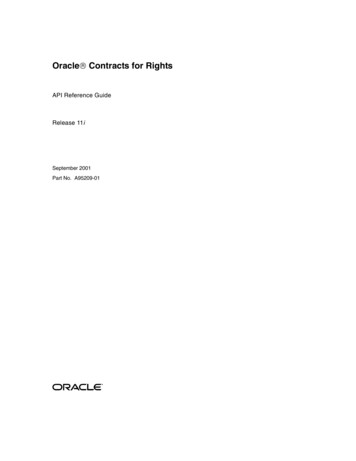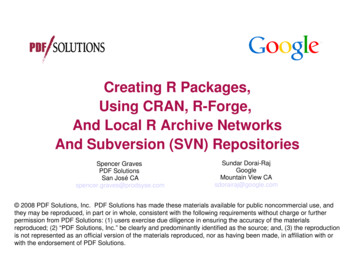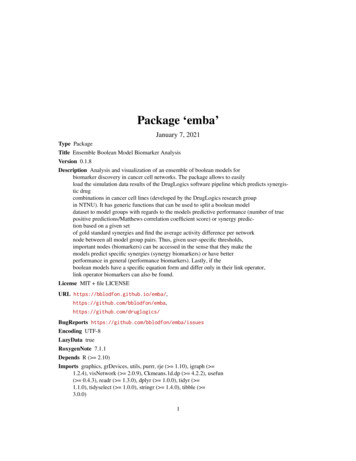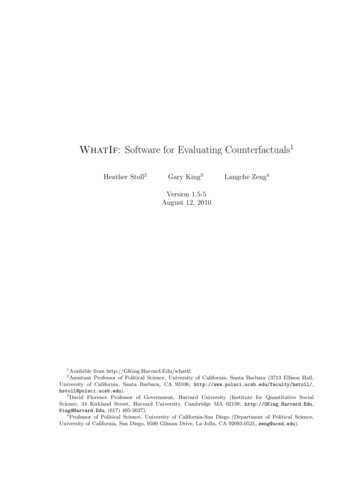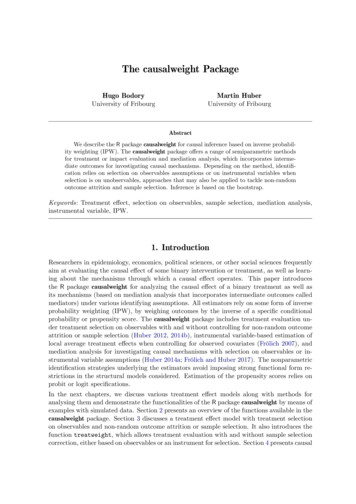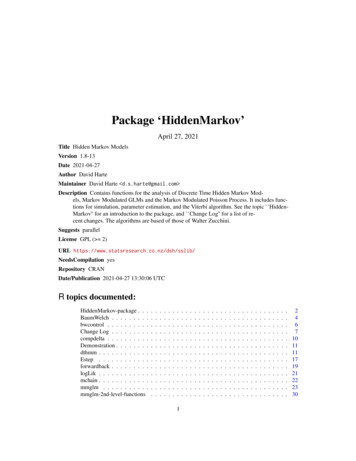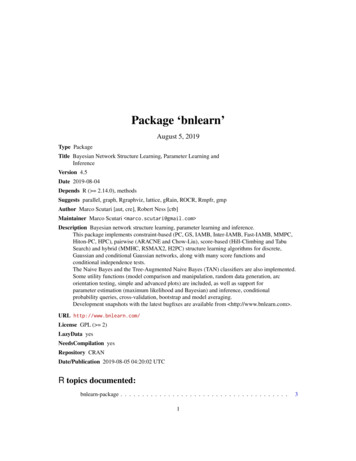
Transcription
Package ‘bnlearn’August 5, 2019Type PackageTitle Bayesian Network Structure Learning, Parameter Learning andInferenceVersion 4.5Date 2019-08-04Depends R ( 2.14.0), methodsSuggests parallel, graph, Rgraphviz, lattice, gRain, ROCR, Rmpfr, gmpAuthor Marco Scutari [aut, cre], Robert Ness [ctb]Maintainer Marco Scutari marco.scutari@gmail.com Description Bayesian network structure learning, parameter learning and inference.This package implements constraint-based (PC, GS, IAMB, Inter-IAMB, Fast-IAMB, MMPC,Hiton-PC, HPC), pairwise (ARACNE and Chow-Liu), score-based (Hill-Climbing and TabuSearch) and hybrid (MMHC, RSMAX2, H2PC) structure learning algorithms for discrete,Gaussian and conditional Gaussian networks, along with many score functions andconditional independence tests.The Naive Bayes and the Tree-Augmented Naive Bayes (TAN) classifiers are also implemented.Some utility functions (model comparison and manipulation, random data generation, arcorientation testing, simple and advanced plots) are included, as well as support forparameter estimation (maximum likelihood and Bayesian) and inference, conditionalprobability queries, cross-validation, bootstrap and model averaging.Development snapshots with the latest bugfixes are available from http://www.bnlearn.com .URL http://www.bnlearn.com/License GPL ( 2)LazyData yesNeedsCompilation yesRepository CRANDate/Publication 2019-08-05 04:20:02 UTCR topics documented:bnlearn-package . . . . . . . . . . . . . . . . . . . . . . . . . . . . . . . . . . . . . . .13
R topics documented:2alarm . . . . . . . . . . .alpha.star . . . . . . . . .arc operations . . . . . . .arc.strength . . . . . . . .asia . . . . . . . . . . . .BF . . . . . . . . . . . . .bn class . . . . . . . . . .bn.boot . . . . . . . . . .bn.cv . . . . . . . . . . . .bn.fit . . . . . . . . . . . .bn.fit class . . . . . . . . .bn.fit plots . . . . . . . . .bn.fit utilities . . . . . . .bn.kcv class . . . . . . . .bn.strength class . . . . . .choose.direction . . . . . .ci.test . . . . . . . . . . .clgaussian.test . . . . . . .compare . . . . . . . . . .configs . . . . . . . . . . .constraint-based algorithmscoronary . . . . . . . . . .cpdag . . . . . . . . . . .cpquery . . . . . . . . . .ctsdag . . . . . . . . . . .dsep . . . . . . . . . . . .foreign files utilities . . . .gaussian.test . . . . . . . .gRain integration . . . . .graph enumeration . . . .graph generation utilities .graph integration . . . . .graph utilities . . . . . . .graphviz.chart . . . . . . .graphviz.plot . . . . . . .hailfinder . . . . . . . . .hybrid algorithms . . . . .impute . . . . . . . . . . .independence-tests . . . .insurance . . . . . . . . .learning.test . . . . . . . .lizards . . . . . . . . . . .lm integration . . . . . . .local discovery algorithmsmarks . . . . . . . . . . .misc utilities . . . . . . . .model string utilities . . .naive.bayes . . . . . . . 48495051525455565859626466676970717273747778
bnlearn-package3network-classifiers . . . .network-scores . . . . . .node ordering utilities . . .pcalg integration . . . . .plot.bn . . . . . . . . . . .plot.bn.strength . . . . . .preprocess . . . . . . . . .rbn . . . . . . . . . . . . .ROCR integration . . . . .score . . . . . . . . . . . .score-based algorithms . .single-node local discoverystrength.plot . . . . . . . .structural.em . . . . . . .structure-learning . . . . .test counter . . . . . . . .whitelists-blacklists . . . 100102103105Bayesian network structure learning, parameter learning and inferenceDescriptionBayesian network structure learning (via constraint-based, score-based and hybrid algorithms), parameter learning (via ML and Bayesian estimators) and inference (via approximate inference se:bnlearnPackage4.52019-08-04GPLv2 or laterbnlearn implements key algorithms covering all stages of Bayesian network modelling: data preprocessing, structure learning combining data and expert/prior knowledge, parameter learning, andinference (including causal inference via do-calculus). bnlearn aims to be a one-stop shop forBayesian networks in R, providing the tools needed for learning and working with discrete Bayesiannetworks, Gaussian Bayesian networks and conditional linear Gaussian Bayesian networks on realworld data. Incomplete data with missing values are also supported. Furthermore the modularnature of bnlearn makes it easy to use it for simulation studies.Implemented structure learning algorithms include:
4bnlearn-package Constraint-based algorithms, which use conditional independence tests to learn conditionalindependence constraints from data. The constraints in turn are used to learn the structure ofthe Bayesian network under the assumption that conditional independence implies graphicalseparation (so, two variables that are independent cannot be connected by an arc). Score-based algorithms, which are general-purpose optimization algorithms that rank networkstructures with respect to a goodness-of-fit score. Hybrid algorithms combine aspects of both constraint-based and score-based algorithms, asthey use conditional independence tests (usually to reduce the search space) and networkscores (to find the optimal network in the reduced space) at the same time.For more details about structure learning algorithms see structure learning; available conditionalindependence tests are described in independence tests and available network scores are describedin network scores. Specialized algorithms to learn the structure of Bayesian network classifiersare described in network classifiers. All algorithms support the use of whitelists and blacklists toinclude and exclude arcs from the networks (see whitelists and blacklists); and many have parallelimplementation built on the parallel package. Bayesian network scores support the use of graphicalpriors.Parameter learning approaches include both frequentist and Bayesian estimators. Inference is implemented using approximate algorithms via particle filters approaches such as likelihood weighting, and covers conditional probability queries, prediction and imputation.Additional facilities include support for bootstrap and cross-validation; advanced plotting capabilities implemented on top of Rgraphviz and lattice; model averaging; random graphs and randomsamples generation; import/export functions to integrate bnlearn with software such as Hugin andGeNIe; an associated Bayesian network repository of golden-standard networks at http://www.bnlearn.com/bnrepository.Use citation("bnlearn") to find out how to cite bnlearn in publications and other materials; andvisit http://www.bnlearn.com for more examples and code from publications using bnlearn.Author(s)Marco ScutariIstituto Dalle Molle di Studi sull’Intelligenza Artificiale (IDSIA)Maintainer: Marco Scutari marco.scutari@gmail.com Referencesreference books:Koller D, Friedman N (2009). Probabilistic Graphical Models: Principles and Techniques. MITPress.Korb K, Nicholson AE (2010). Bayesian Artificial Intelligence. Chapman & Hall/CRC, 2nd edition.Pearl J (1988). Probabilistic Reasoning in Intelligent Systems: Networks of Plausible Inference.Morgan Kaufmann.from the author:Nagarajan R, Scutari M, Lebre S (2013). "Bayesian Networks in R with Applications in SystemsBiology". Springer.
alarm5Scutari M (2010). "Learning Bayesian Networks with the bnlearn R Package". Journal of StatisticalSoftware, 35(3):1–22.Scutari M (20107). "Bayesian Network Constraint-Based Structure Learning Algorithms: Paralleland Optimized Implementations in the bnlearn R Package". Journal of Statistical Software, 77(2):1–20.Examples## the workflow of Bayesian network modelling in bnlearn:# choose the data set to work on.data(learning.test)# . choose an algorithm and learn the structure of the network from the data.net hc(learning.test)# . plot it.## Not run: graphviz.plot(net)# . learn the parameters of the network.bn bn.fit(net, learning.test)# . explore the network with a classic barchart.## Not run: graphviz.chart(bn)# . and perform inference to answer any question that interests you!cpquery(bn, event (A "a"), evidence (C "a"))alarmALARM monitoring system (synthetic) data setDescriptionThe ALARM ("A Logical Alarm Reduction Mechanism") is a Bayesian network designed to provide an alarm message system for patient monitoring.Usagedata(alarm)FormatThe alarm data set contains the following 37 variables: CVP (central venous pressure): a three-level factor with levels LOW, NORMAL and HIGH. PCWP (pulmonary capillary wedge pressure): a three-level factor with levels LOW, NORMAL andHIGH. HIST (history): a two-level factor with levels TRUE and FALSE. TPR (total peripheral resistance): a three-level factor with levels LOW, NORMAL and HIGH. BP (blood pressure): a three-level factor with levels LOW, NORMAL and HIGH. CO (cardiac output): a three-level factor with levels LOW, NORMAL and HIGH. HRBP (heart rate / blood pressure): a three-level factor with levels LOW, NORMAL and HIGH.
6alarm HREK (heart rate measured by an EKG monitor): a three-level factor with levels LOW, NORMALand HIGH. HRSA (heart rate / oxygen saturation): a three-level factor with levels LOW, NORMAL and HIGH. PAP (pulmonary artery pressure): a three-level factor with levels LOW, NORMAL and HIGH. SAO2 (arterial oxygen saturation): a three-level factor with levels LOW, NORMAL and HIGH. FIO2 (fraction of inspired oxygen): a two-level factor with levels LOW and NORMAL. PRSS (breathing pressure): a four-level factor with levels ZERO, LOW, NORMAL and HIGH. ECO2 (expelled CO2): a four-level factor with levels ZERO, LOW, NORMAL and HIGH. MINV (minimum volume): a four-level factor with levels ZERO, LOW, NORMAL and HIGH. MVS (minimum volume set): a three-level factor with levels LOW, NORMAL and HIGH. HYP (hypovolemia): a two-level factor with levels TRUE and FALSE. LVF (left ventricular failure): a two-level factor with levels TRUE and FALSE. APL (anaphylaxis): a two-level factor with levels TRUE and FALSE. ANES (insufficient anesthesia/analgesia): a two-level factor with levels TRUE and FALSE. PMB (pulmonary embolus): a two-level factor with levels TRUE and FALSE. INT (intubation): a three-level factor with levels NORMAL, ESOPHAGEAL and ONESIDED. KINK (kinked tube): a two-level factor with levels TRUE and FALSE. DISC (disconnection): a two-level factor with levels TRUE and FALSE. LVV (left ventricular end-diastolic volume): a three-level factor with levels LOW, NORMAL andHIGH. STKV (stroke volume): a three-level factor with levels LOW, NORMAL and HIGH. CCHL (catecholamine): a two-level factor with levels NORMAL and HIGH. ERLO (error low output): a two-level factor with levels TRUE and FALSE. HR (heart rate): a three-level factor with levels LOW, NORMAL and HIGH. ERCA (electrocauter): a two-level factor with levels TRUE and FALSE. SHNT (shunt): a two-level factor with levels NORMAL and HIGH. PVS (pulmonary venous oxygen saturation): a three-level factor with levels LOW, NORMAL andHIGH. ACO2 (arterial CO2): a three-level factor with levels LOW, NORMAL and HIGH. VALV (pulmonary alveoli ventilation): a four-level factor with levels ZERO, LOW, NORMAL andHIGH. VLNG (lung ventilation): a four-level factor with levels ZERO, LOW, NORMAL and HIGH. VTUB (ventilation tube): a four-level factor with levels ZERO, LOW, NORMAL and HIGH. VMCH (ventilation machine): a four-level factor with levels ZERO, LOW, NORMAL and HIGH.NoteThe complete BN can be downloaded from http://www.bnlearn.com/bnrepository.
alpha.star7SourceBeinlich I, Suermondt HJ, Chavez RM, Cooper GF (1989). "The ALARM Monitoring System: ACase Study with Two Probabilistic Inference Techniques for Belief Networks". Proceedings of the2nd European Conference on Artificial Intelligence in Medicine, 247–256.Examples# load the data.data(alarm)# create and plot the network structure.modelstring paste0("[HIST LVF][CVP LVV][PCWP LVV][HYP][LVV HYP:LVF][LVF]","[STKV HYP:LVF][ERLO][HRBP ERLO:HR][HREK ERCA:HR][ERCA][HRSA ERCA:HR][ANES]","[APL][TPR APL][ECO2 ACO2:VLNG][KINK][MINV INT:VLNG][FIO2][PVS FIO2:VALV]","[SAO2 PVS:SHNT][PAP PMB][PMB][SHNT INT:PMB][INT][PRSS INT:KINK:VTUB][DISC]","[MVS][VMCH MVS][VTUB DISC:VMCH][VLNG INT:KINK:VTUB][VALV INT:VLNG]","[ACO2 VALV][CCHL ACO2:ANES:SAO2:TPR][HR CCHL][CO HR:STKV][BP CO:TPR]")dag model2network(modelstring)## Not run: graphviz.plot(dag)alpha.starEstimate the optimal imaginary sample size for BDe(u)DescriptionEstimate the optimal value of the imaginary sample size for the BDe score, assuming a uniformprior and given a network structure and a data set.Usagealpha.star(x, data, debug FALSE)Argumentsxan object of class bn (for bn.fit and custom.fit) or an object of class bn.fit(for bn.net).dataa data frame containing the variables in the model.debuga boolean value. If TRUE a lot of debugging output is printed; otherwise thefunction is completely silent.Valuealpha.star() returns a positive number, the estimated optimal imaginary sample size value.Author(s)Marco Scutari
8arc operationsReferencesSteck H (2008). "Learning the Bayesian Network Structure: Dirichlet Prior versus Data". Proceedings of the 24th Conference on Uncertainty in Artificial Intelligence, 511–518.Examplesdata(learning.test)dag hc(learning.test, score "bic")for (i in 1:3) {a alpha.star(dag, learning.test)dag hc(learning.test, score "bde", iss a)}#FORarc operationsDrop, add or set the direction of an arc or an edgeDescriptionDrop, add or set the direction of a directed or undirected arc (also known as edge).Usage# arc operations.set.arc(x, from, to, check.cycles TRUE, check.illegal TRUE, debug FALSE)drop.arc(x, from, to, debug FALSE)reverse.arc(x, from, to, check.cycles TRUE, check.illegal TRUE, debug FALSE)# edge (i.e. undirected arc) operationsset.edge(x, from, to, check.cycles TRUE, check.illegal TRUE, debug FALSE)drop.edge(x, from, to, debug FALSE)Argumentsxan object of class bn.froma character string, the label of a node.toa character string, the label of another node.check.cyclesa boolean value. If TRUE the graph is tested for acyclicity; otherwise the graphis returned anyway.check.illegala boolean value. If TRUE arcs that break the parametric assumptions of x, suchas those from continuous to discrete nodes in conditional Gaussian networks,cause an error.debuga boolean value. If TRUE a lot of debugging output is printed; otherwise thefunction is completely silent.
arc operations9DetailsThe set.arc() function operates in the following way: if there is no arc between from and to, the arc from to is added. if there is an undirected arc between from and to, its direction is set to from to. if the arc to from is present, it is reversed. if the arc from to is present, no action is taken.The drop.arc() function operates in the following way: if there is no arc between from and to, no action is taken. if there is a directed or an undirected arc between from and to, it is dropped regardless of itsdirection.The reverse.arc() function operates in the following way: if there is no arc between from and to, it returns an error. if there is an undirected arc between from and to, it returns an error. if the arc to from is present, it is reversed. if the arc from to is present, it is reversed.The set.edge() function operates in the following way: if there is no arc between from and to, the undirected arc from - to is added. if there is an undirected arc between from and to, no action is taken. if either the arc from to or the arc to from are present, they are replaced with theundirected arc from - to.The drop.edge() function operates in the following way: if there is no undirected arc between from and to, no action is taken. if there is an undirected arc between from and to, it is removed. if there is a directed arc between from and to, no action is taken.ValueAll functions return invisibly an updated copy of x.Author(s)Marco Scutari
10arc.strengthExamplesdata(learning.test)res gs(learning.test)## use debug TRUE to get more information.set.arc(res, "A", "B")drop.arc(res, "A", "B")drop.edge(res, "A", "B")reverse.arc(res, "A", "D")arc.strengthMeasure arc strengthDescriptionMeasure the strength of the probabilistic relationships expressed by the arcs of a Bayesian network,and use model averaging to build a network containing only the significant arcs.Usage# strength of the arcs present in x.arc.strength(x, data, criterion NULL, ., debug FALSE)# strength of all possible arcs, as learned from bootstrapped data.boot.strength(data, cluster NULL, R 200, m nrow(data),algorithm, algorithm.args list(), cpdag TRUE, debug FALSE)# strength of all possible arcs, from a list of custom networks.custom.strength(networks, nodes, weights NULL, cpdag TRUE, debug FALSE)# strength of all possible arcs, computed using Bayes factors.bf.strength(x, data, score, ., debug FALSE)# average arc strengths.## S3 method for class 'bn.strength'mean(x, ., weights NULL)# averaged network structure.averaged.network(strength, nodes, threshold)Argumentsxan object of class bn.strength (for mean()) or of class bn (for all other functions).networksa list, containing either object of class bn or arc sets (matrices or data frameswith two columns, optionally labeled "from" and "to"); or an object of classbn.kcv or bn.kcv.list from bn.cv().dataa data frame containing the data the Bayesian network was learned from (forarc.strength()) or that will be used to compute the arc strengths (for boot.strength()and bf.strength()).
arc.strength11clusteran optional cluster object from package parallel.strengthan object of class bn.strength, see below.thresholda numeric value, the minimum strength required for an arc to be included in theaveraged network. The default value is the threshold attribute of the strengthargument.nodesa vector of character strings, the labels of the nodes in the network. In averaged.network,it defaults to the set of the unique node labels in the strength argument.criterion,scorea character string. For arc.strength(), the label of a score function or an independence test; see network scores for details.For bf.strength(), the labelof the score used to compute the Bayes factors; see BF for details.Ra positive integer, the number of bootstrap replicates.ma positive integer, the size of each bootstrap replicate.weightsa vector of non-negative numbers, to be used as weights when averaging arcstrengths (in mean()) or network structures (in custom.strength()) to compute strength coefficients. If NULL, weights are assumed to be uniform.cpdaga boolean value. If TRUE the (PDAG of) the equivalence class is used instead ofthe network structure itself. It should make it easier to identify score-equivalentarcs.algorithma character string, the structure learning algorithm to be applied to the bootstrapreplicates. See structure learning and the documentation of each algorithmfor details.algorithm.args a list of extra arguments to be passed to the learning algorithm.in arc.strength(), the additional tuning parameters for the network score (ifcriterion is the label of a score function, see score for details), the conditionalindependence test (currently the only one is B, the number of permutations). Inmean, additional objects of class bn.strength to average.debuga boolean value. If TRUE a lot of debugging output is printed; otherwise thefunction is completely silent.Detailsarc.strength() computes a measure of confidence or strength for each arc, while keeping fixedthe rest of the network structure.If criterion is a conditional independence test, the strength is a p-value (so the lower the value, thestronger the relationship). The conditional independence test would be that to drop the arc from thenetwork. The only possible additional argument is B, the number of permutations to be generatedfor each permutation test.If criterion is the label of a score function, the strength is measured by the score gain/loss whichwould be caused by the arc’s removal. In other words, it is the difference between the score of thenetwork in which the arc is not present and the score of the network in which the arc is present.Negative values correspond to decreases in the network score and positive values correspond toincreases in the network score (the stronger the relationship, the more negative the difference).There may be additional aguments depending on the choice of the score, see score for details.
12arc.strengthboot.strength() estimates the strength of each arc as its empirical frequency over a set of networks learned from bootstrap samples. It computes the probability of each arc (modulo its direction)and the probabilities of each arc’s directions conditional on the arc being present in the graph (ineither direction).bf.strength() estimates the strength of each arc using Bayes factors to overcome the fact thatBayesian posterior scores are not normalised, and uses the latter to estimate the probabilities of allpossible states of an arc given the rest of the network.custom.strength() takes a list of networks and estimates arc strength in the same way asboot.strength().Model averaging is supported for objects of class bn.strength returned by boot.strength, custom.strengthand bf.strength. The returned network contains the arcs whose strength is greater than thethreshold attribute of the bn.strength object passed to averaged.network().Valuearc.strength(), boot.strength(), custom.strength(), bf.strength() and mean() return anobject of class bn.strength; boot.strength() and custom.strength() also include informationabout the relative probabilities of arc directions.averaged.network() returns an object of class bn.See bn.strength class and bn-class for details.Noteaveraged.network() typically returns a completely directed graph; an arc can be undirected if andonly if the probability of each of its directions is exactly 0.5. This may happen, for example, if thearc is undirected in all the networks being averaged.Author(s)Marco ScutariReferencesfor model averaging and boostrap strength (confidence):Friedman N, Goldszmidt M, Wyner A (1999). "Data Analysis with Bayesian Networks: A Bootstrap Approach". Proceedings of the 15th Annual Conference on Uncertainty in Artificial Intelligence, 196–201.for the computation of the strength (confidence) significance threshold:Scutari M, Nagarajan R (2011). "On Identifying Significant Edges in Graphical Models". Proceedings of the Workshop ’Probabilistic Problem Solving in Biomedicine’ of the 13th ArtificialIntelligence in Medicine Conference, 15–27.See Alsostrength.plot, choose.direction, score, ci.test.
asia13Examplesdata(learning.test)res gs(learning.test)res set.arc(res, "A", "B")arc.strength(res, learning.test)## Not run:arcs boot.strength(learning.test, algorithm "hc")arcs[(arcs strength 0.85) & (arcs direction 0.5), ]averaged.network(arcs)start random.graph(nodes names(learning.test), num 50)netlist lapply(start, function(net) {hc(learning.test, score "bde", iss 10, start net) })arcs custom.strength(netlist, nodes names(learning.test),cpdag FALSE)arcs[(arcs strength 0.85) & (arcs direction 0.5), ]modelstring(averaged.network(arcs))## End(Not run)bf.strength(res, learning.test, score "bds", prior "marginal")asiaAsia (synthetic) data set by Lauritzen and SpiegelhalterDescriptionSmall synthetic data set from Lauritzen and Spiegelhalter (1988) about lung diseases (tuberculosis,lung cancer or bronchitis) and visits to Asia.Usagedata(asia)FormatThe asia data set contains the following variables: D (dyspnoea), a two-level factor with levels yes and no. T (tuberculosis), a two-level factor with levels yes and no. L (lung cancer), a two-level factor with levels yes and no. B (bronchitis), a two-level factor with levels yes and no. A (visit to Asia), a two-level factor with levels yes and no. S (smoking), a two-level factor with levels yes and no. X (chest X-ray), a two-level factor with levels yes and no. E (tuberculosis versus lung cancer/bronchitis), a two-level factor with levels yes and no.
14BFNoteLauritzen and Spiegelhalter (1988) motivate this example as follows:“Shortness-of-breath (dyspnoea) may be due to tuberculosis, lung cancer or bronchitis, or none ofthem, or more than one of them. A recent visit to Asia increases the chances of tuberculosis, whilesmoking is known to be a risk factor for both lung cancer and bronchitis. The results of a singlechest X-ray do not discriminate between lung cancer and tuberculosis, as neither does the presenceor absence of dyspnoea.”Standard learning algorithms are not able to recover the true structure of the network because of thepresence of a node (E) with conditional probabilities equal to both 0 and 1. Monte Carlo tests seemsto behave better than their parametric counterparts.The complete BN can be downloaded from n S, Spiegelhalter D (1988). "Local Computation with Probabilities on Graphical Structuresand their Application to Expert Systems (with discussion)". Journal of the Royal Statistical Society:Series B, 50(2):157–224.Examples# load the data.data(asia)# create and plot the network structure.dag model2network("[A][S][T A][L S][B S][D B:E][E T:L][X E]")## Not run: graphviz.plot(dag)BFBayes factor between two network structuresDescriptionCompute the Bayes factor between the structures of two Bayesian networks.UsageBF(num, den, data, score, ., log TRUE)Argumentsnum, dendatascore.logtwo objects of class bn, corresponding to the numerator and the denominatormodels in the Bayes factor.a data frame containing the data to be used to compute the Bayes factor.a character string, the label of a posterior network score. If none is specified,the default score is the Bayesian Dirichlet equivalent score (bde) for discretenetworks and the Bayesian Gaussian score (bge) for Gaussian networks. Otherkinds of Bayesian networks are not currently supported.extra tuning arguments for the posterior scores. See score for details.a boolean value. If TRUE the Bayes factor is given as log(BF).
bn class15ValueA single numeric value, the Bayes factor of the two network structures num and den.NoteThe Bayes factor for two network structures, by definition, is the ratio of the respective marginallikelihoods which is equivalent to the ration of the corresponding posterior probabilities if we assume the uniform prior over all possible DAGs. However, note that it is possible to specify differentpriors using the “.” arguments of BF(); in that case the value returned by the function will notbe the classic Bayes factor.Author(s)Marco ScutariSee Alsoscore, compare, bf.strength.Examplesdata(learning.test)dag1 model2network("[A][B][F][C B][E B][D A:B:C]")dag2 model2network("[A][C][B A][D A][E D][F A:C:E]")BF(dag1, dag2, learning.test, score "bds", iss 1)bn classThe bn class structureDescriptionThe structure of an object of S3 class bn.DetailsAn object of class bn is a list containing at least the following components: learning: a list containing some information about the results of the learning algorithm. It’snever changed afterward.– whitelist: a copy of the whitelist argument (a two-column matrix, whose columnsare labeled from and to) as transformed by sanitization functions.– blacklist: a copy of the blacklist argument (a two-column matrix, whose columnsare labeled from and to) as transformed by sanitization functions.
16bn class– test: the label of the conditional independence test used by the learning algorithm (acharacter string); the la
Description Bayesian network structure learning, parameter learning and inference. This package implements constraint-based (PC, GS, IAMB, Inter-IAMB, Fast-IAMB, MMPC, Hiton-PC, HPC), pairwise (ARACNE and Chow-Liu), score-based (Hill-Climbing and Tabu Search) and hybrid (MMHC, RSMAX2, H2PC) structure learning algorithms for discrete,
